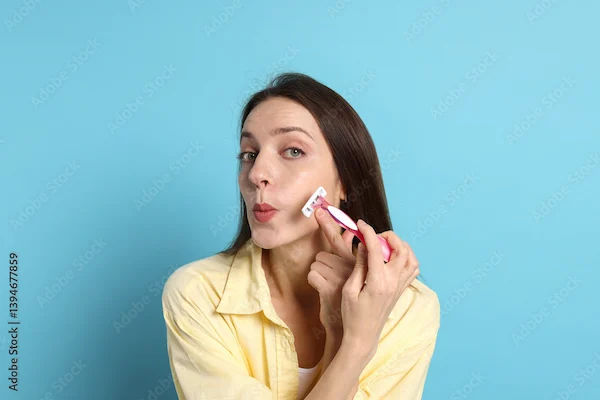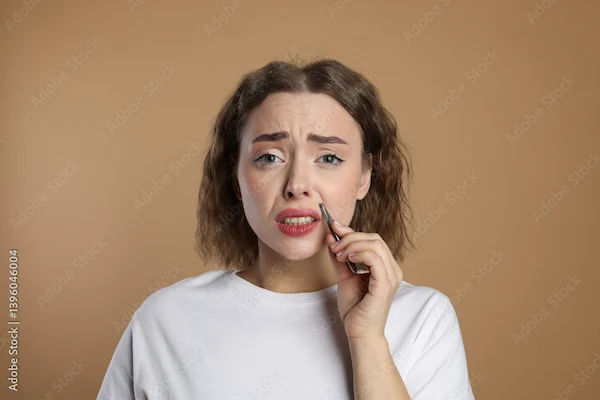Hirsutism Treatment Guide: Managing Excessive Hair Growth
Hirsutism causes excessive hair growth in women due to hormonal imbalances or medical conditions. Explore effective treatments, including medications, hair removal methods, and lifestyle changes to manage unwanted hair growth.

Written by Dr.Sonia Bhatt
Last updated on 3rd Jul, 2025

Introduction
Hirsutism is a condition characterised by excessive hair growth in women, typically in areas where men usually grow hair, such as the face, chest, and back. While hirsutism itself is not a harmful condition, it can be emotionally distressing, affecting a person's self-esteem and quality of life. Fortunately, several treatment options can help manage the symptoms of hirsutism and restore confidence.
In this guide, we’ll cover various effective treatments and management strategies for controlling excessive hair growth, including medications, hair removal techniques, and lifestyle modifications. Let’s explore the best ways to address this condition and find a solution that works for you.
What is Hirsutism?
Hirsutism is often a result of an underlying hormonal imbalance, particularly elevated levels of androgens (male hormones) in women. Common causes include polycystic ovary syndrome (PCOS), certain medications, congenital adrenal hyperplasia, and, in some cases, idiopathic hirsutism, where the cause is unknown. Symptoms can include abnormal hair growth, acne, irregular menstrual cycles, deepening of the voice, and thinning hair on the scalp.
Understanding these causes and symptoms is the first step towards effective management. If you experience these symptoms, it's important to consult a healthcare provider for proper diagnosis and treatment.
Treatment Options for Hirsutism
Hirsutism treatment depends on the severity of the condition, the underlying cause, and your personal preferences. Below are the most effective and widely recommended treatment options.
Direct Intervention for Underlying Disorders
Treating the root cause of hirsutism, if identified, is essential. For instance, managing PCOS with lifestyle changes, medications, or surgery can reduce hirsutism symptoms. In cases where the underlying cause cannot be addressed, other treatment options are necessary. Once the underlying cause is managed or ruled out, it’s time to consider other treatment strategies to help control and reduce excessive hair growth.
Cosmetic Treatments for Hirsutism
Cosmetic treatments offer quick and effective ways to manage the visible symptoms of hirsutism. While these methods don't address the underlying hormonal imbalance, they can help improve self-esteem and provide immediate relief from excessive hair growth. Here are some common cosmetic treatments:
Shaving
Description: Shaving removes hair from the surface of the skin using a razor.
Pros: Quick, easy, inexpensive, and can be done at home.
Cons: Needs to be done frequently as it doesn't remove hair from the root. It may cause skin irritation or razor burn. Some women find it psychologically unacceptable.
Plucking
Description: Plucking involves removing individual hairs using tweezers.
Pros: Effective for small areas like the eyebrows or chin. Provides longer-lasting results compared to shaving.
Cons: Time-consuming and can be painful. It may cause skin irritation, folliculitis (inflammation of hair follicles), and scarring.
Waxing
Description: Waxing involves applying a layer of wax to the skin, which is then quickly removed to pull out hair from the root.
Pros: Provides longer-lasting results compared to shaving or plucking, as it removes hair from the root. It can be done at home or in a salon.
Cons: Painful and can cause skin irritation, folliculitis, and scarring. Requires hair to grow to a certain length before it can be waxed again.
Depilatory Creams
Description: Depilatory creams contain chemicals that break down the protein structure of hair, allowing it to be easily wiped away.
Pros: Easy to use and can be done at home. Provides smooth results.
Cons: It may cause skin irritation, especially in sensitive individuals. The results are temporary, similar to shaving.
Laser Hair Removal
Description: Laser hair removal uses concentrated beams of light to target and destroy hair follicles, reducing hair growth over time.
Pros: Provides long-lasting results and can significantly reduce hair growth. It can improve psychological well-being by reducing anxiety and depression associated with hirsutism.
Cons: It can be expensive and requires multiple sessions. It may cause temporary skin irritation, redness, and swelling. It is not suitable for all skin and hair types.
Electrolysis
Description: Electrolysis uses a fine needle to apply an electrical current to hair follicles, destroying them and preventing future hair growth.
Pros: Offers permanent hair removal. Effective for all skin and hair types.
Cons: Time-consuming and can be painful. Each hair follicle needs to be treated individually. It may cause skin irritation and scarring if not done properly.
Systemic Treatments for Hormonal Imbalance
Systemic treatments aim to lower male hormone levels or block their effects on hair growth. While these treatments can be effective, they typically take time to show results and may come with potential side effects. As such, it’s important to have informed consent and regular check-ins with a healthcare provider.
Glucocorticoids: Medications like dexamethasone and prednisone can reduce hormone levels, but they may cause side effects like weight gain.
Oral Contraceptives (OCs): Birth control pills are commonly used to lower hormone levels, regulate menstrual cycles, and can be combined with other treatments for better results. However, they may not be suitable for everyone, particularly those with a history of migraines or blood clotting issues.
Spironolactone: This medication blocks the effects of male hormones and is helpful for women with high blood pressure or fluid retention. It’s important to use reliable contraception while on spironolactone due to the risk of birth defects.
Finasteride: Although primarily used for prostate issues in men, finasteride can also reduce hair growth in women. It’s typically recommended only for postmenopausal women due to the risk of birth defects.
Flutamide: This powerful medication blocks male hormones and is effective, but it can be expensive and may cause severe side effects, including liver damage.
Insulin Sensitizers: Medications like metformin help improve insulin resistance and reduce hormone levels. This is particularly useful for women with PCOS who are struggling with hirsutism.
Important Considerations for Hirsutism Treatment
When managing hirsutism, it's crucial to keep several important considerations in mind to ensure effective and safe treatment:
Personalised Treatment Plan: Hirsutism treatment should be customised based on the individual's specific condition, preferences, and health status. Factors such as the severity of hair growth, the area affected, and any underlying medical conditions must be considered when choosing a treatment approach.
Combining Treatments: Combining systemic therapies with cosmetic treatments often yields the best results. Systemic therapies work gradually to reduce androgen levels, while cosmetic treatments provide immediate hair removal. For example, using oral contraceptives or spironolactone alongside laser hair removal can offer both short-term and long-term benefits.
Managing Expectations: It's important to understand that hirsutism treatment is often a gradual process. Systemic therapies can take six months to a year to show noticeable results, and even then, only about half to three-quarters of patients experience significant improvement. Patience and persistence are key.
Monitoring and Follow-Up: Regular follow-up appointments with a healthcare provider are crucial to monitor the progress of treatment, manage any side effects, and make necessary adjustments. Ongoing communication helps ensure that the treatment plan remains effective and safe.
Exploring New Therapies: Stay informed about the latest advancements in hirsutism treatments. Research into newer therapies, such as 5-alpha-reductase inhibitors and androgen receptor blockers, holds promise for more effective treatment options. Discussing these emerging therapies with a healthcare provider can help determine if they are suitable for you.
Lifestyle and Self-Care: Incorporating healthy lifestyle choices, such as maintaining a balanced diet, regular exercise, and stress management, can support overall well-being and potentially improve hirsutism symptoms.
Conclusion
Effectively managing hirsutism requires a personalised and thorough approach. This may involve an accurate diagnosis, a combination of systemic and cosmetic treatments, and regular monitoring with your healthcare provider. It's important to manage expectations, as it can take several months to see noticeable results. Always consult with a healthcare professional for advice and treatment options tailored to your specific needs.
Consult Top Dermatologists
Consult Top Dermatologists

Dr. K Chetana
Dermatologist
10 Years • MBBS, MD ( Dermatology)
Hyderabad
Apollo 24|7 Clinic, Hyderabad

Dr Ridhima Lakhani
Dermatologist
10 Years • MBBS, MD, DNB
New Delhi
Apollo 24|7 Clinic - Delhi, New Delhi
(25+ Patients)

Dr. Hemalatha Naidu M
Dermatologist
5 Years • MBBS, MD (Dermatology)
Bangalore
Apollo 24|7 Clinic - Karnataka, Bangalore
(250+ Patients)
Dr. Gauri Padmawar
Dermatologist
9 Years • MBBS, DDV, Certificate in Aesthetic
Pune
Dr. Aniruddha's advance ortho and polyclinic, Pune

Dr. Somshukla Ray
Dermatologist
10 Years • MBBS, MD (Dermatology,Venerology & Leprosy), DNB (Dermatology,Venerology & Leprosy)
Kolkata
MCR SUPER SPECIALITY POLY CLINIC & PATHOLOGY, Kolkata
(25+ Patients)
